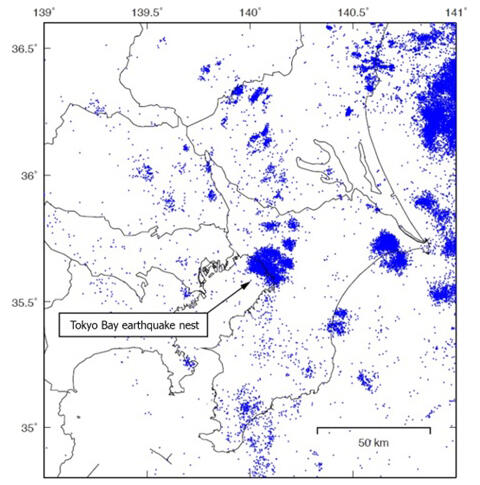Professor Junichi Nakajima of the Department of Earth and Planetary Sciences, Graduate School of Science and Engineering at the Institute of Science Tokyo has proposed a new perspective suggesting that the earthquake nest (an area of concentrated seismic activity isolated from surrounding activity) in the northern part of Tokyo Bay (Northwest Chiba Prefecture) at depths of 60-70 kilometers is caused by seamounts subducting with the Pacific Plate. This significant finding contributes to understanding seismic activity in the Tokyo metropolitan area and was published online in the scientific journal Tectonophysics on April 6, 2025.

Provided by Science Tokyo
Northern Tokyo Bay is one of the most seismically active regions in Japan, experiencing approximately 100 earthquakes per month, including small imperceptible ones. Of the three earthquakes that caused seismic intensity of 5 upper or greater in Tokyo's 23 wards over the past century, two originated from northern Tokyo Bay. The 1894 Meiji Tokyo earthquake may also have occurred near this area.
On the oceanic floor of the Pacific Plate before subduction, there are somewhat isolated topographic elevations that rise more than 1,000 meters from the seafloor with small summit diameters. These are seamounts, believed to be remnants of past igneous activity, and their distribution and size have been well studied.
About 300 kilometers offshore from the Kanto region lies the "Joban seamount chain," which extends in a northeast-southwest direction. These seamounts vary in size, with radii of 5-20 kilometers and heights of 1,000-3,000 meters from the seafloor surface.
Through seismic wave data analysis, Nakajima examined in detail the hypocenter locations and spatial characteristics of the seismic activity of M2+ earthquakes (at depths of 55-75 kilometers) that occurred in the Tokyo Bay earthquake nest between 2000 and 2023.
The results showed that the size of the earthquake nest closely matches that of the seamounts offshore from the Kanto region, and the spatial pattern of seismic activity is consistent with characteristics expected from seamount subduction. Based on these findings, Nakajima proposed a new "seamount subduction model" as the cause of the earthquake nest.
Nakajima also pointed out that the northern Tokyo Bay earthquake nest could potentially be the source region for an M7-class earthquake anticipated as a potential earthquake directly beneath Tokyo. The nest has a radius of approximately 10 kilometers, which is sufficient to generate an M7-class earthquake.
Analysis of recurring seismic activity in the same location suggests that strain is accumulating in the earthquake nest. If the entire region corresponding to the nest were to rupture at once, an M7-class earthquake could occur.
The Kanto region has been known for its active seismicity, previously attributed to the subduction of two oceanic plates: the Pacific Plate and the Philippine Sea Plate.
This research reveals the possibility that seamount subduction is a factor influencing seismic activity, in addition to the previously known factors. The results of this research provide a new perspective on the causes of earthquake nests distributed throughout the Kanto region. However, the "seamount subduction model" is proposed based on circumstantial evidence such as the extent and spatial characteristics of seismic activity, rather than direct observation of seamount subduction. Moreover, the factors behind the different seismic activity characteristics between the northern and southern sides of the seamounts remain unclear.
Nakajima stated that further systematic investigation and research on the relationship between pre-subduction oceanic plate topography and post-subduction interplate seismic activity characteristics in many regions around the world will be necessary to verify the "seamount subduction model."
Journal Information
Publication: Tectonophysics
Title: The Tokyo Bay earthquake nest, Japan: Implications for a subducted seamount
DOI: 10.1016/j.tecto.2025.230728
This article has been translated by JST with permission from The Science News Ltd. (https://sci-news.co.jp/). Unauthorized reproduction of the article and photographs is prohibited.




